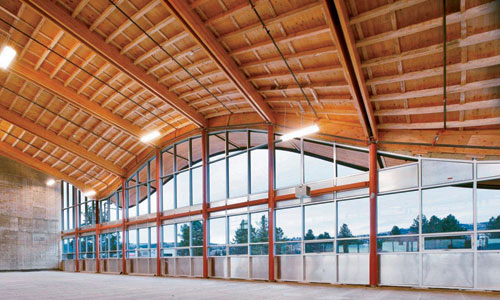Wood's New Wave
In Tall Wood, a 2012 report written by Green and Karsh, the authors emphasize that the green-building movement would do well to consider other wood-based panel systems to maximize resource efficiency, performance, and economy in the production of various types of buildings in different parts of the world. For example, they point to two engineered-wood products long manufactured in North America—laminated-strand lumber (LSL), which is made from wood chips, and laminated-veneer lumber (LVL), which is made from wood veneer. Currently available as beams, these products are initially manufactured in large billets that are then sliced up into individual members. The authors suggest that the billets could serve as structural panels in and of themselves before they are cut.
Designers, of course, must be aware of the differences in dimensions and performance among such components. Panels of LSL and LVL are thinner and stronger than CLT but can span only in one direction, so they need to be supported by beams if oriented vertically as walls. And while CLT comes as large as 40 feet by 10 feet, panels of LSL and LVL are manufactured up to 64 feet by 8 feet.
Furthermore, these products can be made from different types of trees of varying ages. CLT is usually built up of soft woods, like spruce and fir, from trees around 40 years old. Green notes that CLT is particularly appropriate in Canada, which is trying to make use of large tracts of pine trees that have been decimated by a beetle that has proliferated because of rising winter temperatures. If not used, these dead trees will eventually rot or burn, contributing additional greenhouse gases to the atmosphere.
 |
|
Glulam and solid-sawn wood panels were prefabricated and shipped to the site. Photo © Florian Maurer |
In contrast, LSL is made up from hardwoods—such as aspen, maple, and poplar—that are around 10 to 15 years old, making it a more rapidly renewable source. In addition, such young trees consume more carbon dioxide than older trees, so a shorter growing cycle translates into greater carbon sequestration.
Green suggests that mass-timber materials could be produced from a variety of trees, depending on what is regionally available. And the panels themselves can be designed differently, depending on product availability or project needs.
A case in point is the North Vancouver Civic Centre, completed in 2012. Green was commissioned to renovate and link two neighboring buildings—the existing North Vancouver City Hall and a vacated library—to make a new, larger complex for the city administration. The design called for a 216-foot-long central atrium that would span the 32 feet between the existing structures. Green and structural engineer Karsh used this as an opportunity to engage LSL and LVL manufacturers in discussions about potentially supplying the materials to customers in their larger billet format before they are cut into the more familiar commodity products.
These talks proved fruitful. The finished mass-timber roof structure consists of 17 custom panels fabricated from 3.5-inch-thick LSL layered in a cross-laminated fashion to create an overall panel thickness of 14 inches. Both glue and screws were used to attach the various layers. The designers created cavities inside the large panels by using smaller LSL components to provide room for acoustical insulation and the sprinkler system. An exposed surface serves as the finished ceiling. The custom mass-timber panels were prefabricated in a shop and lowered by crane onto glulam columns.









